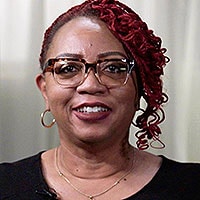This transcript has been edited for clarity.
Monica Peek: Hi. I’m Dr Monica Peek, and this is Care Cues. I’m thrilled to be joined with my colleague and friend, Sheila Harmon. Thanks for joining us. Today, we’re going to be talking about shared decision-making for patients who have type 2 diabetes and are African American. And you are the perfect person to be joining me today because you not only have diabetes, but you are also an expert in helping others manage the disease. I think it’s really important that we take a step back and talk about the social drivers of health. And what we know is that things like employment, our built-in social environment, and whether we have insurance; when people don’t have a job, they don’t have the same kinds of resources as affluent communities. And the lack of those things affects their health.
Sheila Harmon: You mentioned not having a job, being unemployed, but also childcare. When you don’t have childcare, and when you’re trying to get to your provider’s office, you don’t have transportation. You have some areas where people are afraid to go out and walk because of the violence. And even if you’re trying to call a ride share, they don’t want to come to certain communities. So, when you start to look at all of that, that affects a person’s health.
Peek: When we’re trying to manage diabetes in the clinic, we have to be aware that we have to also manage the racism that people have been exposed to if we’re going to try and get them to wellness.
Harmon: Absolutely.
Peek: People who come in and have experienced some of the structural inequities in their life. What we call structural racism. So, lack of access to goods and services because of the neighborhoods they live in or discrimination that has led to different qualities of care. What are some of the experiences that you have heard about?
Harmon: I realize that we have to pay attention to our own biases, right? When somebody comes in and we look at them and they may seem unclean, that could be the best that they have. We have some patients where they said, “I didn’t have washing powder to wash my clothes,” but they did the best they could to have on something clean to come in.
And what we do is make sure that our team understands the culture of the patients that we see. We try to have diversity on our team because what we heard was patients come in and say, “I don’t see anybody who looks like me. You’re telling me all these things that I do. What do they know? I don’t see anybody who looks like me.”
So, we had to look at our team to make sure that whatever community our health center is in, that they come in and they see somebody that looks like them.
Peek: We have to. And so that people can see themselves in their providers. But it’s a whole team approach. Because when you’ve gone to the doctor, and you’ve been waiting and somebody at the front desk has a bad attitude.
Harmon: Yes.
Peek: I cannot tell you the number of times the first thing people tell me before they even say hello is I almost left because of the person at the check in, and so then I’ve got to spend 5 minutes apologizing for someone who had a bad attitude. So, we’re all a family. It’s all a team.
And everybody has to be rowing in that same direction, thinking about our patients, knowing that. Everyone who touches the life of that patient can make a difference.
Harmon: Like you said, from the time they come to the front desk, [those at] the front desk are the ones who say, “Oh no, well we’re not going to see you because you’re 15 minutes late, you know.” And so, what we’ve learned is this, if they made it to the appointment, we need to see them. Because we may not capture them again.
Peek: Most people who have diabetes have type 2 diabetes. And we know that epidemic is largely being driven by the obesity epidemic. If you are a low-income person, you’re more likely to live in an obesogenic environment — one where there’s lots of fast food, where there’s lots of calorie-dense but nutrient-poor food, but less likely to have healthy food options that are affordable.
In addition, we know that cortisol is the main driver of weight gain and diabetes, and we know that populations that are chronically stressed from discrimination, from poverty, and from adverse childhood events have higher cortisol levels.
What are some of the solutions or some of the strategies as a diabetes educator that you have thought about in working with patients?
Harmon: We have had a team go out to actually see what’s in the local grocery stores. What would it take for you to be able to add these items in the store so that people could purchase the items?
We heard one local store saying, “Well, if I bought those things, they wouldn’t buy them. And then they would go to waste.” So we said, “Well, what if we could come into the store, and we bring some of these items, show the community how to prepare them, let them taste it and sample it here to see if we could then get them to buy the items.” And so, a partnership like that worked.
Peek: We all know that people with diabetes are supposed to have 150 minutes per week of physical activity. But that is more challenging if you’re in a city where there may be more violent crimes, where people may not feel safe going out. You’re less likely to have green spaces, clean air, places to exercise, gyms, walkable areas, and sidewalks, those kinds of things. So, it’s really hard to live a healthy life if you’re Black and poor.
Harmon: Absolutely. Those are valid realities for where we live. We’ve also partnered with churches because with the churches, the sanctuaries, some of them are big enough where people can walk.
We’ve encouraged people to get together in a community, and maybe somebody has a vehicle, and they go to the shopping mall. And they go to the shopping mall and walk around inside of the mall to be able to get steps in. And so, we’ve looked at different ways of listening to the community to be able to say what can we do for finding that partnership?
Peek: Tell me some of the strategies that you use in your practice to make sure that your patients feel like they’re heard and that you’re sharing decisions with them.
Harmon: One of the things that I do in our practice is we huddle. We huddle every morning. We look to see who’s coming in, is there anything we need to share about the patient? Making sure that we have everything that we need, so that when a patient comes in, they know we’re ready and we were prepared for the visit. And then when a patient comes in, I always look at the patient goals that they set for themselves. And ask the question, “Well, how are you doing? The last time we talked, you said you were going to maybe do 10 minutes of exercise 4 days a week. How are you doing with that? Did you get up to the 10 minutes, 4 days?”
And they may say, “Well, you know, only got up to 3 days.” “Well, that’s really good.” You know, and we’re excited. “Well, that’s really good. So, the next time I see you, let’s try to get up to 4 days or maybe let’s take those 3 days and try to get up to 12 minutes. What do you think will work for you?” And make sure that they make the decision before they leave.
Harmon: I’m living it too. I have to take my medicine too. I have to check in and when I come see you, I am the patient. So being able to come and have my list that we can go through, what are the important things that I need to tell you today and give you that information and stand in my role at that time as a patient?
And I provide the feedback to let you know how my experience was. When I go back to my job, I tell my staff how my experience was from the front desk all the way until I’m done with you. I say to my team, this is what we’re not going to do. This is what I experienced.
Harmon: So, Dr Peek, what do you do to reach those patients that are still struggling with being able to accept that they have the disease or being ready for change?
Peek: My first strategy for anything is to sit down with a patient and have a real heart to heart about what’s going on. Things that you may not think are relevant to your health are always going to be relevant to your health. I’m always going to want to know about them. If it’s something that’s going on at your job, something that’s going on in your marriage, if it’s something that’s going on whatever, that’s going to affect your emotional health, which is going to affect your behaviors, which is going to affect your health. So, anything that’s happening in your life, I’m going to want to know about it. And so, trying to create a space for people’s entire lived experience, for them to know that that is all health related.
Harmon: Yes.
Peek: And people are not so complicated. They’re coming to the doctor because they want to get better.
Harmon: Yes.
Peek: They want to get better.
Harmon: And they keep coming, so they do.
Peek: They want to get better. So that’s what they’re telling you with their behaviors. So, you’ve got to figure out how to match that behavior with creating the opportunity for them to tell you with their words what they need. And until we have decided as a country that we’re going to treat everyone the same, everyone gets to live in safe housing. Everyone gets to be treated fairly and equally.
Harmon: Absolutely.
Peek: Without fear. You know, I am a physician. I have a comfortable income.
Harmon: I know.
Peek: But I have a 16-year-old son who’s Black. And I’m terrified every day when he leaves my house of what will happen to him. My life is different in that way, my stress level will not go down. And so, I think that we have to think more broadly about the causes of disease than individual behaviors and think about the structural factors that shape the choices and constrain choices that people have.
Harmon: Absolutely.
Peek: Thank you so much for joining me today. It’s just always, it’s always wonderful. Thank you
Harmon: Thank you for the opportunity to be here with you.










